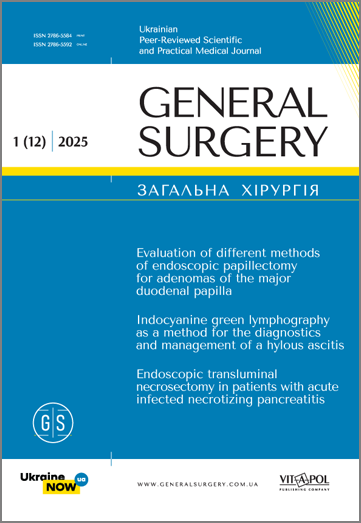A rare case of complicated hernioplasty and reconstruction of the gastroesophageal junction: multistage treatment with a positive outcome
DOI:
https://doi.org/10.30978/GS-2025-1-66Keywords:
hiatal hernia, fundoplication, surgical complications, double‑track reconstruction, gastric necrosis, mesh erosionAbstract
This clinical case presents the complex and multistage management of a 48‑year‑old woman with a recurrent hiatal hernia following previous laparoscopic surgical treatment. The initial surgery was complicated by technical errors, leading to early recurrence of the hernia. Subsequent laparoscopic reintervention included mesh‑reinforced hernioplasty and revision fundoplication. However, the postoperative course was complicated by the development of acute gastric fundus ischemia and necrosis, which necessitated urgent atypical wedge resection of the stomach. Despite initial recovery, the patient later developed further complications, including a mesh‑related gastric ulceration and the formation of a chronic inflammatory infiltrate in the upper abdominal cavity. These adverse events required a relaparotomy, complete mesh removal, proximal gastrectomy, and complex gastrointestinal reconstruction using the double‑tract method. The management of this case illustrates several critical challenges: the risk of ischemic complications following fundoplication, the long‑term sequelae of mesh implantation at the gastroesophageal junction, and the technical considerations necessary for successful reconstruction after proximal gastrectomy. Special attention was paid to minimizing postoperative reflux, preserving nutritional function, and ensuring a high quality of life. This clinical case highlights the importance of careful patient selection, meticulous surgical technique, and the necessity for early recognition and management of postoperative complications. Through a stepwise, multidisciplinary surgical approach, a positive long‑term outcome was achieved, with the patient demonstrating good tolerance to a regular diet, no signs of reflux, and satisfactory functional recovery.
References
Braghetto I, Korn O, Rojas J, Valladares H, Figueroa M. Hiatal hernia repair: prevention of mesh erosion and migration into the esophagogastric junction. Arq Bras Cir Dig. 2020;33(1):e1489. http://doi.org/10.1590/0102-672020190001e1489.
Clinical Outcomes of Proximal Gastrectomy versus Total Gastrectomy for Proximal Gastric Cancer: A Systematic Review and Meta-Analysis. Lulu Zhao, Rui Ling, Jinghua Chen, Anchen Shi, Changpeng Chai, Fuhai Ma, Dongbing Zhao, Yingtai Chen. Dig Surg. 2021;38(1):1-13. http://doi.org/10.1159/000506104.
DeMeester TR, Bonavina L, Albertucci EM. Nissen fundoplication for gastroesophageal reflux disease: evaluation of primary repair in 100 consecutive patients. Ann Surg. 1986;204:9-20.
Effect of Laparoscopic Proximal Gastrectomy With Double-Tract Reconstruction vs Total Gastrectomy on Hemoglobin Level and Vitamin B12 Supplementation in Upper-Third Early Gastric Cancer: A Randomized Clinical Trial. Park DJ, Han SU, Hyung WJ, et al. JAMA Netw Open. 2023;6(2):e2256004. http://doi.org/10.1001/jamanetworkopen.2022.56004.
Hiatal Hernia Repair: A Century Between Soresi and da Vinci. McClinton A, Zarnegar R, Dakin G, Afaneh C. Surg Clin North Am. 2025;105(1):125-142. http://doi.org/10.1016/j.suc.2024.06.010.
Hunter JG, Trus TL, Branum GD, Waring JP, Wood WC. A physiologic approach to laparoscopic fundoplication for gastroesophageal reflux disease. Ann Surg. 1996;223:673-687.
Hybrid hiatal hernia repair: is it cost-effective? Satoskar S, Kashyap S, Chang A, et al. J Robot Surg. 2022;16(6):1361-1365. http://doi.org/10.1007/s11701-021-01364-8.
Is fundoplication necessary after paraesophageal hernia repair? A meta-analysis and systematic review. Clapp B, Hamdan M, Mandania R, et al. Surg Endosc. 2022;36(8):6300-6311. http://doi.org/10.1007/s00464-022-09024-0.
Is it meaningful to add mesh reinforcement to laparoscopic fundoplication for esophageal hiatal hernias in patients with high risk of recurrence? Tsuboi K, Masuda T, Omura N, et al. Esophagus. 2024;21(1):67-75. http://doi.org/10.1007/s10388-023-01026-8.
Kane TD. Laparoscopic Nissen fundoplication. Minerva Chir. 2009;64(2):147-157. PMID:19365315.
Li J, Cheng T. Mesh erosion after hiatal hernia repair: the tip of the iceberg? Hernia. 2019;23(6):1243-1252. http://doi.org/10.1007/s10029-019-02011-w.
Lima DL, de Figueiredo SMP, Pereira X, et al. Hiatal hernia repair with biosynthetic mesh reinforcement: a qualitative systematic review. Surg Endosc. 2023;37(10):7425-7436. http://doi.org/10.1007/s00464-023-10379-1.
Little AG, Ferguson MK, Skinner DB. Reoperation for failed antireflux operations. J Thorac Cardiovasc Surg. 1986;91:511-517.
Morse C, Pennathur A, Luketich JD. Laparoscopic techniques in reoperation for failed antireflux repairs. In: Patterson GA, Pearson FG, Cooper JD, eds. Pearson’s textbook of thoracic and esophageal surgery. Philadelphia, PA: Churchill Livingstone; 2008:367-375.
Peters JH, DeMeester TR. Indications, benefits and outcomes of laparoscopic Nissen Fundoplication. Dig Dis. 1996;14:169-179.
Quality of life comparison between esophagogastrostomy and double tract reconstruction for proximal gastrectomy assessed by Postgastrectomy Syndrome Assessment Scale (PGSAS)-45. Ikeda M, Takiguchi N, Morita T, et al. Ann Gastroenterol Surg. 2022;7(3):430-440. http://doi.org/10.1002/ags3.12645.
Rausa E, Manfredi R, Kelly ME, et al. Prosthetic reinforcement in hiatal hernia repair, does mesh material matter? A systematic review and network meta-analysis. J Laparoendosc Adv Surg Tech A. 2021;31(10):1118-1123. http://doi.org/10.1089/lap.2020.0752.
Role of fundoplication in treatment of patients with symptoms of hiatal hernia. Li ZT, Ji F, Han XW, et al. Sci Rep. 2019;9(1):12544. http://doi.org/10.1038/s41598-019-48740-x.
Smith DC, McClusky DA, Rajad MA, Lederman AB, Hunter JG. When fundoplication fails: redo? Ann Surg. 2005;241:861-871.
Smith RE, Sharma S, Shahjehan RD. Hiatal Hernia. In: StatPearls [Internet]. Treasure Island (FL): StatPearls Publishing; 2025 Jan–. PMID:32965871.
Surgical strategies for recurrent hiatal hernia: three-point fundoplication fixation. Chu Y, Liu Y, Hua R, Yao Q. BMC Surg. 2025;25(1):18. http://doi.org/10.1186/s12893-025-02760-9.
The comparison of post-proximal gastrectomy digestive tract reconstruction methods. Yang Xia, Nengquan Sheng, Zhigang Wang, Qingchao Zhu. MC Surg. 2025;25(1):1. http://doi.org/10.1186/s12893-024-02748-x.
Useful of proximal gastrectomy with double-tract reconstruction in preventing glucose spikes. Fujimoto D, Taniguchi K, Takashima J, Kobayashi H. J Gastrointest Surg. 2024;28(9):1479-1484. http://doi.org/10.1016/j.gassur.2024.06.012.
Downloads
Published
How to Cite
Issue
Section
License
Copyright (c) 2025 Authors

This work is licensed under a Creative Commons Attribution-NoDerivatives 4.0 International License.






